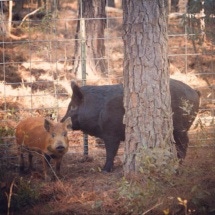Despite steep costs of damage, survey respondents reported very little investment in hog control, such as trapping or fencing.
November 22, 2016

Feral hogs are a $115 million problem for the South Carolina’s agriculture, livestock and timber industries, according to a Clemson University study on landowners’ perceived damages from the invasive animals.
This is the first time a comprehensive dollar figure has been attached to the ecological and industry damages in the state caused by wild hogs, which reproduce rapidly and are growing in numbers.

Invasive feral hogs are trapped on a rural property. Image Credit: Susan Sullivan.
“They are ecological zombies. They eat everything. They eat deer fawn. They uproot endangered salamanders. They eat ground-nesting birds and their eggs. They really eat anything,” said Shari Rodriguez, report author and assistant professor in the forestry and environmental conservation department.
The hogs also prey on wildlife and livestock and consume large amounts of agricultural crops and seeds, sprouts and seedlings, which disrupts reforestation. Their rooting, wallowing and nesting behaviors decrease water quality and promote soil erosion. They can also spread diseases like pseudorabies and brucellosis, which can spread to humans.
“It is shocking how many diseases they carry,” Rodriguez said. “They are vectors for a lot of diseases that can be passed on to livestock or other wild animals, too. It’s best to wear gloves when handling them.”
Rodriguez surveyed 2,500 farmers and rural members of the South Carolina Farm Bureau (SCFB) to better understand their perceptions of wild hogs and the cost of damage caused by these invasive pigs brought to North America by European settlers centuries ago to hunt.
Rodriguez’s report estimates perceived damages based on survey responses but does not report actual damages. The nearly 750 survey responses gave Rodriguez a basis to estimate overall damages in the state, however, and provides insights on landowners’ views on feral hogs and how they control them.
The report estimates $44 million in damage to crops, livestock and timber across the state. Landowners reported another $71 million in non-crop losses from damage to wildlife food plots, streams, ponds, wetlands, equipment, vehicles, unpaved roads, fire lanes and landscaping.
Despite the steep costs of damage, respondents reported very little investment in hog control, such as trapping or fencing.
“They need to be eradicated, not just controlled,” said Marion Barnes, a senior agent with the Clemson Cooperative Extension Service. “They’re a nuisance wildlife and they need to be treated as such. I deal with the destructive nature of them day after day when I visit farms and see what they do to corn crops and peanut crops. I’ve got nothing good to say about feral hogs.”
An estimated 130,000 to 140,000 wild hogs live in South Carolina, an increase of around 30% over the past decade, said Charles Ruth, wildlife biologist with the South Carolina Department of Natural Resources. Hogs tend to be densely populated and can cause severe damage to one landowner’s property while a landowner just a few miles away may have no hog problem at all, he said.
Feral hogs have been present in South Carolina for centuries, Ruth said, but were once confined to coastal regions of the state and controlled locally. Now hogs are establishing themselves in new areas as people catch, transport and release them for hunting, Ruth said. State law prohibits the release of hogs in the wild as well as the removal of live hogs from forests without a permit, Ruth said.
SCFB advocates legislation to require domestic hogs be certified and tagged when transported to market, which could close a loophole some use to relocate feral hogs, said Gary Spires, director of government relations at SCFB.
“Over the last several years, we have seen more and more acreage being affected by wild hogs,” he said. “They tear up crops and damage fields. In some cases, farmers have to go in and repair the field because damage has been getting so bad. The other thing that we are very, very fearful of is the spread of disease. Our livestock folks are very aware of that.”
Feral hogs are intelligent animals that can adapt to trapping methods, Rodriguez said.
“If you don’t remove the entire population in that sounder (herd), you’ve just educated the hogs that didn’t get trapped. Once you’ve failed to catch the whole sounder in a particular trap setup, you’d better switch the trap setup if you hope to capture the rest,” she said.
Feral hogs reach sexual maturity at just six months of age and can reproduce three times a year with an average litter size of five, though litters range from one to 13 piglets, Rodriguez said. Adult hogs have few native predators. Beyond alligators in the lower part of the state, humans are the only native predators of adult wild hogs, she said.
“Those biological characteristics contribute to the knowledge that their population is going to grow exponentially and already is growing exponentially,” Rodriguez said.
Rodriguez’s report indicates that rural property owners view wild hogs as more of a nuisance than a beneficial animal to hunt. She said a comprehensive study on actual damages from wild hogs would be advantageous in understanding the threat to the state’s $41.7 billion agriculture and forestry industry or the need to pursue new methods of control or eradication.
You May Also Like



